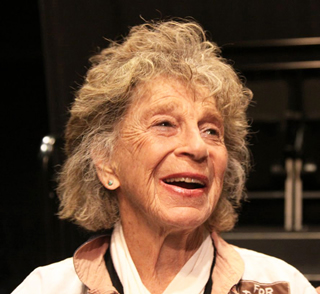Dance of a Lifetime - Page 5
 |
|
|
 |
|
|
"Expression," she told a recent class, "takes you closer to dance as an art."
"When you take movement and make it your own, then it becomes art."
Anna and Larry continued to influence each other throughout their careers. In the mid-1960s Larry developed a system that involved graphic 'scores' to solve design problems when working with clients or the community. Anna translated the process for dance. Landscape design and dance began to blend.
Larry began to see landscapes in terms of dance, and used the process to design urban landscapes, bringing in residents to take part in workshops and semi-theatrical events. "An environment," he wrote, "is in fact simply a theater for action and interaction to occur."
Using a score, Anna sets out certain rules for a dance—how to move, whether or not to touch, how much force to use, what props to use—then lets dancers improvise to develop the final piece.
In 1966, summer workshops were held at Sea Ranch, the trend-setting community of wood-sided modern homes, some designed by architect Charles Moore, who took part in the workshops. Larry designed the eco-sensitive landscaping for Sea Ranch.
Throughout her career Anna has addressed social and political issues in her work, driven, she says, by the anti-Semitism she has faced since she was a girl in suburban Chicago.
She had created such immersive events as 'City Dance,' first performed in 1977 in San Francisco, with scored performances by amateurs and professionals throughout San Francisco, and 'Planetary Dance: A Call for Peace.'
"I'm drawn towards situations going on in the world around me," she says. "What I seem to be drawn to right now that has been happening recently is what is going on in Israel. I'm connected to Israel."
Her next work was to be a collaborative effort with an Israel dance group, first in New York, then in Israel.
Despite her distancing of herself from mainstream dance, Halprin had been amply recognized, winning many top dance awards. Among the legendary dancers and choreographers who trained on the dance deck and acknowledged her influence were Yvonne Rainer, Trisha Brown, and Meredith Monk.
Halprin says her public dances helped inspire the current vogue for self-expression in the streets. "Flash mobs are doing wonderful things now," she says. "When we did it, it was very new."
"It's a reflection of a need for release," she says about flash mobs and similar unscripted events, "because we are living in a world that is so threatening. Every day you read something more about what's happening with the water, with the environment. People have a great need for releasing stress.
"There has been some progress. There's less anti-Semitism. But there's not been enough progress for survival, so I think people need spontaneous expression more than ever."
Photos: David Toerge, Ernie Braun, Edloe Risling, William Steig, Peter Larsen, Paul Ryan, Shawn P. Calhoun; and courtesy Anna Halprin
Anna Halprin died May 24, 2021.




